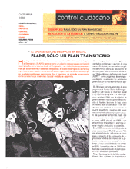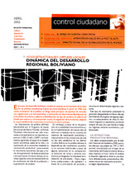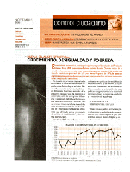Bolivia
|
Published on Wed, 2009-09-30 15:13
• La condicionalidad del Fondo Monetario Internacional plasmada en la Estrategia Boliviana de Reducción de la Pobreza.
• Desarrollo Sostenible en Johannesburgo: el derrumbe de las cumbres mundiales.
» |
|
Published on Wed, 2009-09-30 15:06
• Dinámica del desarrollo regional boliviano: vicios estructurales y ¿virtudes locales? • Presupuesto General de la Nación 2001: El espejo de nuestra fragilidad fiscal. • Dilemas del servicio de salud en La Paz y en El Alto. • Informe Social Watch 2001: Impacto social de la globalización en el mundo.
» |
|
Published on Wed, 2009-09-30 15:02
• Dilemas del Ajuste: las inequidades del modelo
• Desempleo ilustrado: los desencantos de la política social
• EBRP: una estrategia que camina a tropiezos
» |
|
The PRGF and the EBRP within the framework of the Structural Adjustment Programme:
Letter of Intend and PRGF. The EBRP and the HIPC Initiative. The application of neoclassical policies in Bolivia . Evolution of basic macroeconomic indicators: Savings; investment; income; role of the State and dependency; social and economic results. Conclusions.
|
|
As a cycle of world growth roared past, Bolivia stood by and watched, unable to take advantage of the opportunity to establish its own rhythm of development. Its economy was just beginning to pick up speed, when the global boom began to stall and then go into reverse. In recent years, distributive tendencies in the world economy have been weak. Bolivian entrepreneurs are part of this trend, responding to the severe global downturn through unequal negotiations that shift the burden of the crisis onto the shoulders of their workers through layoffs and reductions in benefits and wages.
|

 • Una evaluación de 14 meses de aplicación del Plan Nacional de Empleo de Emergencia (PLANE)
• Una evaluación de 14 meses de aplicación del Plan Nacional de Empleo de Emergencia (PLANE)



